Korfball exercises for u12
- 6 players at the pawns, 1 in front.
- The one in front of the pawns tries to find a hole to get through by feints.
- Defender may only move left right.
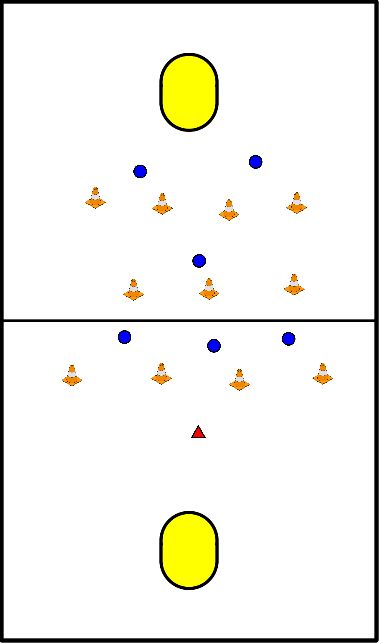
- Two players have two pawns between them in two different colors.
- Number the pawns 1 and 2 or to a color, for example, red and white.
- Players put the pawns between each other and plank.
- When the coach calls out a color or number, as quickly as possible hand on it.
- The player who is first wins, best of 5.
- Winners move one way, losers the other.
- 1 player takes an out-of-bounds ball in front of the basket.
- And rebounds the ball inside.
- Then goes the same way to the outside.
- The player shoots only after he/she goes outside.
- The exercise can be extended to include a through ball.
- It is important to pass continuously with the outside hand.
- We divide the group into 2 or 3.
- The trainer counts down and then all groups get to shoot at the same time.
- If you score in one shot, you get 3 points.
- If you catch the ball without hitting the ground, you get 1 point.
- Then you take the rebound right away for 2 points.
Only the square and not the diamond is used in this form of training. The primary training objectives here are:
- Keeping space in the box, through running lines in a square
- Timely replenishment of vacant position, timing running moments.
- Passing ball at pace to next player.
Note: the square must be smaller because the diamond is not used initially. Player must be at a distance they can throw.
For the exercise, there is an inside and outside square marked by pawns. So players are not allowed to go outside that path and therefore not make the square smaller than that:
- Player 1 plays to 2 -> runs after own ball at reasonable pace;
- Player 2 plays directly to 3 -> runs at reasonable pace after own ball;
- etc.
- The ball pace goes up slowly.
- When the children have this under control, the ball goes the other way.
The ball should be passed quickly and passed faster and faster.
Eventually, players should always be able to get to the empty spot just in time, because the pace of the ball is almost faster than that of the players.
Eventually, players should always be able to get to the empty spot just in time, because the pace of the ball is almost faster than that of the players.
Playing tight balls is a requirement here.
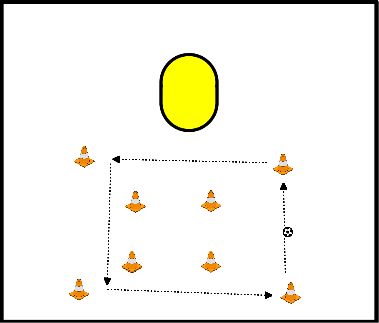
- 1 player stands under the basket.
- The other player stands approximately 3/ 4 meters in front of the basket.
- The player moves to the right and receives the ball on the outside hand.
- Quickly stands up properly for the shot and shoots from a balance, this must be quick.
- In the beginning this exercise still on two legs.
- After the ball is caught, the player moves to the left and everything repeats itself.
- Maximum of 5 shots per person and then switch.
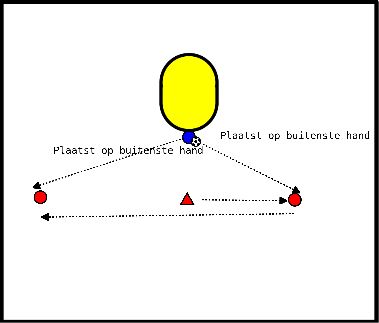
- You are going to throw up from 2 meters distance
- If you get it right 10 times, step back to a certain point
- Then you go back and throw on 1 leg
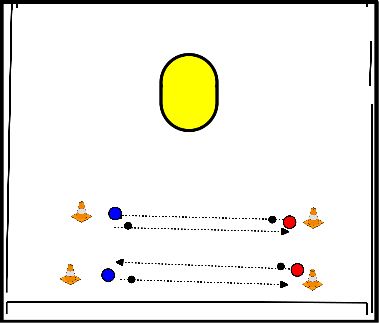
Player A cuts inside to take a through ball and Player B throws it to him/her. Player A catches his/her own ball and moves to Player B's position, etc.
To make it tougher, you can have the person indicating the ball catch it himself/herself.
To make it tougher, you can have the person indicating the ball catch it himself/herself.
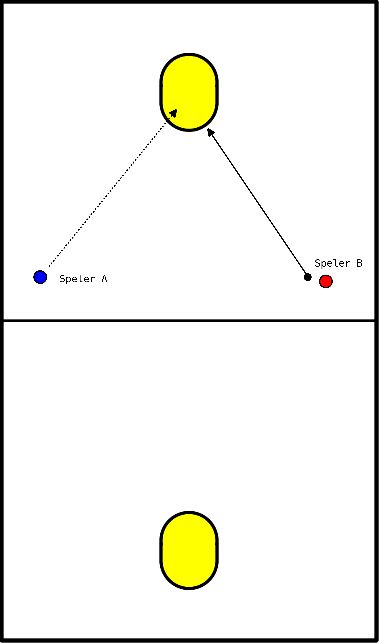
As a quieter exercise in between:
- 2-tal shoot under the post until the 11
- then the 11 again and back to 0.
To make it more difficult you can subtract 1 per miss or per time the ball falls to the ground.
- Per person, everyone must score 10 through balls, this goes in groups of 3 or 4.
- In case of a miss, the whole group goes to the other side of the field on pace run and back.
- The one who missed takes the chance again.
- Until 10 are scored per player.
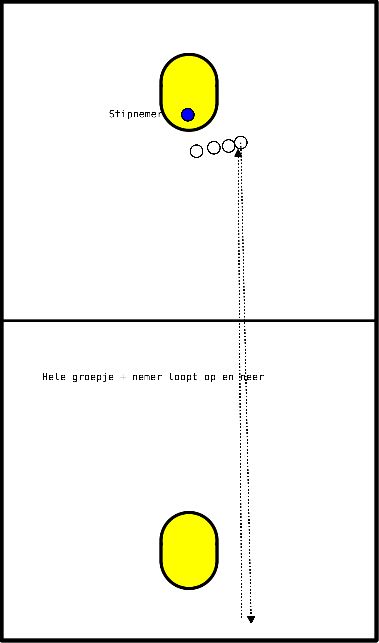
Objective:
The base is a standard running form exercise, where you have players move back and forth in different ways to train general motor skills.
The tap game element adds responsiveness by having players react as quickly as possible and determine what they are going to do.
The tap game element adds responsiveness by having players react as quickly as possible and determine what they are going to do.
Description:
- The players stand on a line and are given a way by the trainer to run across each time, see also running forms.
- All players have a ribbon on, 1-3 players with the same color.
Occasionally, while walking back and forth, the trainer calls out the color of 1 of the ribbons. These then become the tickers. The tickers get 10 seconds to tap as many of the remaining players as possible. - Then all return to the same line and start a running form again.
- The idea is to start the tagging round immediately when the trainer calls a color and to quickly start the next running form when the tagging round is over. Keep up the pace.
Variations:
Instead of running forms where players walk back and forth, you can do movement exercises standing in the same spot. Examples include Jumping Jacks, sitting/lying and getting up again, jumping forward and backward, etc.
The trainer occasionally gives the next movement assignment and calls a color to start a tap round.
Running Forms:
Standard
- Running / Running backwards
- Hopping / Hopping backwards
- Sideways with front right / Sideways with front left
- Small steps
- Hopping on right / Hopping on left
- Cross pass
Jumps
- Jumps as large as possible.
- Medium-sized jumps and always balancing on 1 foot for a while before taking the next jump.
- With two feet side by side.
- With two feet side by side a big jump forward and another small jump back.
- With two feet zigzagging.
Arm movements to be combined with the above forms.
- Swing 1 arm forward or backward.
- Swing both arms forward, or both backward.
- 1 arm forward and 1 arm backward.
- Holding another body part with 1 or both arms.
As animals
- Frog; jumping on hands and feet.
- Crab; on hands and feet, with belly up.
- Kangaroo; jumping on two legs.
- Flamingo; hopping.
- Duck; crouching walk.
The trainer occasionally gives the next movement assignment and calls a color to start a tap round.
Running Forms:
Standard
- Running / Running backwards
- Hopping / Hopping backwards
- Sideways with front right / Sideways with front left
- Small steps
- Hopping on right / Hopping on left
- Cross pass
Jumps
- Jumps as large as possible.
- Medium-sized jumps and always balancing on 1 foot for a while before taking the next jump.
- With two feet side by side.
- With two feet side by side a big jump forward and another small jump back.
- With two feet zigzagging.
Arm movements to be combined with the above forms.
- Swing 1 arm forward or backward.
- Swing both arms forward, or both backward.
- 1 arm forward and 1 arm backward.
- Holding another body part with 1 or both arms.
As animals
- Frog; jumping on hands and feet.
- Crab; on hands and feet, with belly up.
- Kangaroo; jumping on two legs.
- Flamingo; hopping.
- Duck; crouching walk.
- Indicate from space.
- Player walks to pilon and makes sideways move to left or right.
- Clearly makes 3 passes sideways facing the basket.
- Then follows a through ball.
- Defender follows and tries to give as much pressure as possible.








